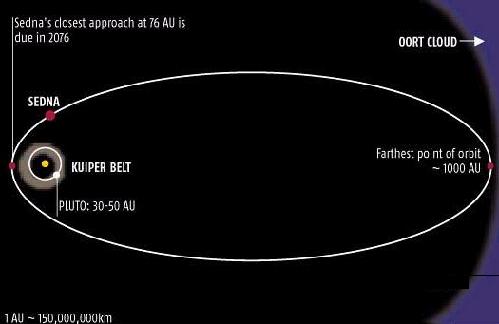When Sedna was discovered in November 2003, it was the largest object discovered since the discovery of Pluto. It puzzled the astronomers because its rotation around its axis lasted 20 days and due to the slow rotation, which indicates the existence of a moon
Ariel Eisenhandler, Israel Astronomical Society

The mystery surrounding Sadna - the most distant object ever observed in the solar system - deepens: according to astronomers' calculations, the "missing" moon of the planetoid belongs to a completely new type of celestial objects and is the darkest body in the entire solar system.
When Sedna was discovered in November 2003, it was the largest object discovered since the discovery of Pluto. It puzzled the astronomers because its rotation around its axis lasted 20 days. A slow rotation usually indicates the existence of a moon, which acts as a brake and slows down the rotation of the planetoid around itself by exerting tidal forces on it. But no companion was found, despite searches by NASA's Hubble and Spitzer space telescopes. Astronomers theorize that Sedna once had a moon that slowed its rotation on its axis, but a collision with an interplanetary ice block knocked it off course. Now, a team from the UK has shown that if Sedna has a moon, it is more likely to be a giant extinct comet than a planetary body.
Assuming the moon exists, Chandra Wickramasinghe and his colleagues at Cardiff University in the UK calculated its maximum possible light reflectance based on the fact that space telescopes could not see it. "If there is a moon then it must be the darkest body in the solar system," says Wickramasinghe.
"crab trap"
The only surface that even comes close to such darkness is built on a comet when the ice that reflects light evaporates into space and leaves behind a deposit of carbonaceous material smeared with tar. The key to the extreme darkness of such surfaces is that they are not solid but more like frozen smoke, and include voids in 85 percent of their volume. This makes them a "crab trap" for light - 99 percent of all photons that fall on the surface layer are trapped. But in order to slow down its workshop its moon has to be hundreds of times larger than any known comet, which puts it in a league of its own. "If true, Sadna's moon points to the existence of a dark solar system self-population somewhere," says Wickramasinghe, whose work appears in the August issue of The Observatory.
Rotation speed rate
The workshop's discoverer, Michael Brown of the California Institute of Technology in Pasadena, is skeptical. "I am very suspicious of these surgeries," he says. "Theoreticians take numbers and interpret them. However, that doesn't mean it's not true."
He points to the fact that if the observations made by the 1.3m telescope at Cerro Tololo in Chile were made at intervals close to the true rate of rotation, this could fool everyone into believing that Sedna is rotating more slowly. It's like looking at a clock every 25 hours and concluding that the hour hand only moves between two adjacent digits.
Brown promises to solve the mystery soon. "We are returning to using the Hubble Space Telescope and will optimize our observing programs to search for the Moon. If he is there, we will see him this time."
